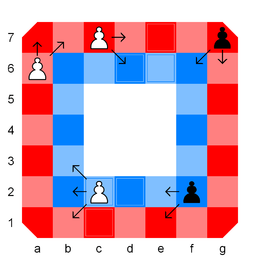
- Chess World Cup
- FIDE Grand Prix
- Olympiad
- World Championship
- List of strong tournaments
- List of world championships

- Checkmate patterns
- Chess openings
- Chess strategy
- Chess tactics
- Chess theory
- Endgames
- Pawn structure
- Problems/Compositions












 Rollerball gameboard and starting position
Rollerball gameboard and starting positionRollerball is a chess variant invented by Jean-Louis Cazaux in 1998. The game was inspired by the 1975 science-fiction movie Rollerball, specifically the futuristic and violent sport (similar to Roller Derby) portrayed in the film.
The board comprises 7x7 squares with the central 3x3 section missing. Pieces generally move clockwise around the board. Each player starts with one king, one bishop, two rooks, and two pawns.
The initial setup is as shown. White moves first. Pieces move and capture the same as their chess counterparts, except where explained differently below.
There are two ways to win in Rollerball:
The same as in chess, stalemate and threefold repetition of position are draws.
In general, forward movement means clockwise direction around the board; backward movement means counterclockwise direction. The squares comprising the board's inner and outer perimeters are called rings. The ring a rook or pawn currently stands on determines its orthogonal forward direction, and for a rook, its orthogonal backward direction. An orthogonal rook move in a direction immediately off its ring is called sideways movement.
 Red and blue are used to highlight the board's rings. A pawn always moves one step straight forward on the ring it currently stands, or one step diagonally forward to either ring. A pawn never moves backward on its ring, or sideways off its ring.
The rook can move forward to any white dot, including one rebound off the a1 corner. It can also move sideways (yellow dot), or one step backward on its ring (green dot). The bishop can move to gray dots, rebounding off the inner board perimeter (f5), or move one diagonal step backward (green dot).
The rook can move to any white dot, rebounding once off a7. It can move one step backward on its ring (green dot), but has no sideways move available. The bishop can move to any gray dot, rebounding once off the exterior perimeter (d1). It can also move one step backward (green dot).
Red and blue are used to highlight the board's rings. A pawn always moves one step straight forward on the ring it currently stands, or one step diagonally forward to either ring. A pawn never moves backward on its ring, or sideways off its ring.
The rook can move forward to any white dot, including one rebound off the a1 corner. It can also move sideways (yellow dot), or one step backward on its ring (green dot). The bishop can move to gray dots, rebounding off the inner board perimeter (f5), or move one diagonal step backward (green dot).
The rook can move to any white dot, rebounding once off a7. It can move one step backward on its ring (green dot), but has no sideways move available. The bishop can move to any gray dot, rebounding once off the exterior perimeter (d1). It can also move one step backward (green dot). The kings move the same as kings in chess: one step in any direction. The bishop can move forward diagonally to white dots (including one rebound off b8), or one step diagonally backward (green dot). The rook is in a very powerful position in the diagram; without assistance, it has the black king in checkmate.
The kings move the same as kings in chess: one step in any direction. The bishop can move forward diagonally to white dots (including one rebound off b8), or one step diagonally backward (green dot). The rook is in a very powerful position in the diagram; without assistance, it has the black king in checkmate.